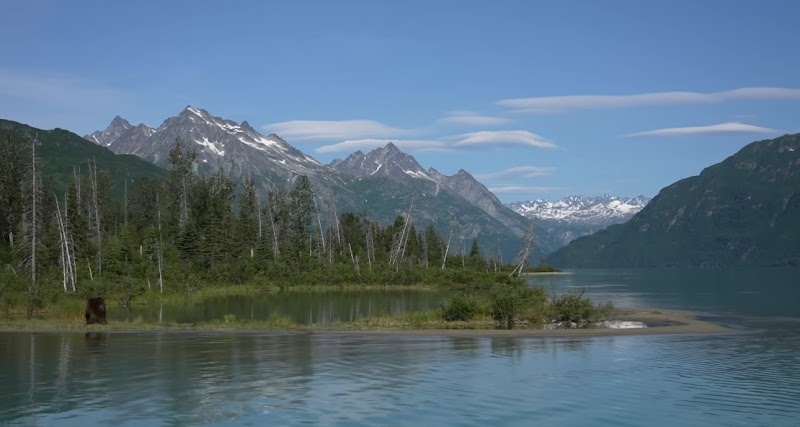
The Kvichak River offers a fly fishing experience like no other in Alaska’s wild landscapes. Home to some of the largest sockeye and king salmon runs in the world, it challenges anglers with its powerful currents and pristine beauty, rewarding preparation and patience with unforgettable battles.
Pack Sturdy Footwear
The rocky riverbanks can be slippery and uneven. Boots with solid grip and waders with reinforced soles improve safety and mobility.
Monitor Weather Closely
Sudden weather changes can cause rapid rises in river levels. Always check local forecasts and be prepared to alter plans accordingly.
Respect Wildlife Distances
Bears are common during salmon runs. Keep food sealed and maintain a safe distance to avoid conflicts and protect both yourself and the animals.
Use Barbless Hooks
To minimize harm to fish and comply with local regulations, use barbless fly fishing hooks when angling on the Kvichak River.
Fishing the Last Frontier: Fly Fishing for Salmon on the Kvichak River
The Kvichak River in Alaska doesn't just flow—it commands. This wild artery, racing from the glacial depths of Iliamna Lake down to Bristol Bay, dares anglers to match its pulse. Fly fishing for salmon here is an engagement with a force that is fiercely itself—currents push forward with a practiced strength, and salmon surge upstream like warriors returning from battle.
The river’s character is raw, with broad runs framed by tangled alder and spruce forests where the air tastes of pine and chilly river spray. Anglers stand waist-deep on rocky banks or camp along gravel bars, gear ready, eyes scanning for the telltale flashes of silver amid the ripples. The main quarry—sockeye and king salmon—arrive in waves from June through July, creating a seasonal frenzy valued by locals and visitors alike.
Preparation is as much a part of the adventure as the cast itself. Expect the terrain to be uneven and slippery; sturdy waders and boots with solid treads make all the difference when navigating the river’s rocky edges and shifting gravel bars. The Kvichak’s unpredictability means monitoring weather patterns closely—sudden storms can swell waters swiftly, turning a calm stretch into a roaring challenge.
Timing your visit matters. Early summer offers cool, crisp mornings and calmer waters, perfect for sight fishing. By mid-July, the river teems with salmon, and the air buzzes with avian life feeding on this abundant resource. Camping along the riverbank is popular but requires vigilance—bears track the salmon runs with near-human precision, demanding responsible food storage practices.
Fly fishing here isn't about conquering a river; it is about reading and respecting an ancient pulse. Successful anglers cultivate patience, reading water currents like a skilled language and timing their casts to match the rhythm of the fish. The Kvichak’s salmon are powerful and spirited opponents—engage with them with skill and humility.
For those drawn by the lure of pristine wilderness and the challenge of fishing a river that remains one of the last true wild salmon sanctuaries, the Kvichak delivers. It's an adventure grounded in respect—both for the fish you seek and the river that carries them.
Nearby Trips
All Adventures
Boat Charters
Water Activities
Adventures near Iliamna, Alaska
Discover the unique and memorable adventures that make Iliamna, Alaska special.
Frequently Asked Questions
When is the best time to fish for salmon on the Kvichak River?
The prime time is from mid-June to mid-July when sockeye and king salmon run upstream in large numbers, creating excellent fishing conditions.
Are permits required for fishing on the Kvichak River?
Yes, anglers must secure appropriate Alaska state fishing permits and follow Bristol Bay fishery regulations, including gear restrictions and catch limits.
What type of salmon can I expect to catch here?
Sockeye (red) salmon are the most abundant, but king salmon (Chinook) also make appearances, offering a challenging and rewarding fight.
How should I prepare for encounters with bears?
Carry bear spray, make noise while moving, store food securely, and maintain a safe distance if you spot wildlife. Know local safety protocols.
Can I camp along the Kvichak River?
Yes, camping on gravel bars and designated riverbanks is common during the fishing season, but campers must practice Leave No Trace and wildlife safety measures.
What are typical weather conditions to expect during the fishing season?
Summer weather is variable—mornings can be cool and crisp, afternoons may warm up, but sudden rainstorms and wind gusts are frequent, so prepare for all conditions.
Recommended Gear
Breathable Waders
Keeps you dry and comfortable while standing in cold water for extended periods during fishing.
Wading Boots with Felt or Rubber Soles
Provides the necessary traction on slippery, uneven rocks alongside the river.
Barbless Fly Fishing Kit
Complies with conservation standards and improves catch-and-release outcomes.
Bear Spray and Food Containers
Essential for safety in an area with frequent bear activity during salmon runs.
Local Insights
Hidden Gems
- "The ‘Deadman’s Reach’ section offers secluded fishing spots where the river narrows and fish gather."
- "A small, gravel beach near the river’s mouth provides excellent birdwatching opportunities during salmon runs."
Wildlife
- "Brown bears and black bears actively feed on salmon here, especially during peak runs."
- "Bald eagles nest heavily in river valley trees, swooping low to snatch fish."
History
"The Kvichak River has long been a critical subsistence and commercial fishing site for Dena'ina and Yup'ik people, with traditions still influencing local fishing practices today."
